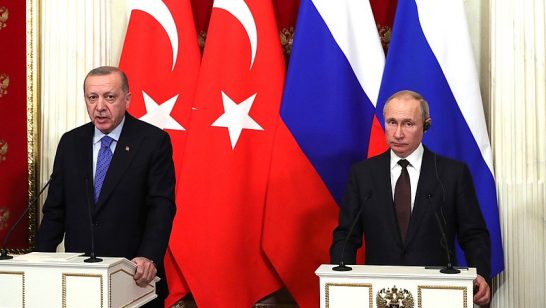
On the morning of the 24 November, a Russian SU-24 tactical bomber was shot down in the Turkish-Syrian border region. Turkish sources insist that the plane was downed by its F-16s after flying over Turkey’s Hatay Province. Multiple sources indicate that the Russian aircraft was warned no less than ten times within five minutes with no response,[1] before being brought down by an air-to-air missile. The aircraft crashed in Syria and the ejected pilots landed in Latakia province. The Russian Ministry of Defence, and later President Putin, maintained that the aircraft was shot down over Syrian territory and did not enter Turkish airspace. Initial reports suggest that one pilot was killed, with the second falling into the hands of an anti-Assad militia. Following a rescue mission this pilot has been returned to a Russian airbase.
The situation is dynamic and there will surely be new information and new developments on the ground and internationally. Still, we don’t have the luxury of sitting on the side-lines and waiting for the dust to settle. Where do we go from here?
Firstly, the priority should be to establish the facts of the case. There are large discrepancies between the Turkish and Russian versions of events. However, it should be possible to get to the bottom of the assertions and counter-assertions, using the data which will hopefully be presented by all sides involved. These should include information from radar and recorded communication between the planes and the command centres, as well as information on the procedures and rules of engagement which were in place. We can’t afford the crucial facts of the incident to be covered by the fog of information warfare.
It remains to be determined whether the Russian military did not receive and/or properly interpret previous Turkish warnings and signals about their rules of engagement, or (even more worryingly) they decided to ignore them and proceed with operations in the border area, assuming that the Turkish side would not react forcefully to airspace violations.
Secondly, all sides should work towards de-escalating the crisis. Immediately after the shoot-down, we have seen a powerful and menacing statement from President Putin and a rebuke from President Erdogan. At the same time, the fact that Turkey did not request a meeting under NATO’s Article 4 crisis consultation procedure would suggest that the Turkish side may want to defuse tensions. Reactions from the US and a number of other Turkish allies are of a similar nature, as they call for calm and de-escalation. NATO Secretary General pronounced NATO’s solidarity with Turkey, but also called for dialogue.
The Russian reaction will therefore be crucial. It may choose to escalate the situation by retaliating against Turkey and its interests, on the pretext of “siding with ISIL”. It may even move to present the whole incident as an element of the US / NATO intrigue against Russia, aimed at torpedoing its operation in Syria. That would considerably raise the level of danger, moving us all to the brink of conflict.
Russia may however choose a different path, giving the primacy to diplomacy. It may want to focus on the need to fully explain the incident, and declare a willingness to work with Turkey. It could pause or significantly limit the operations of its air forces in the vicinity of the Turkish-Syrian border, perhaps with the exception of the military actions against the group(s) which targeted the Russian pilots and the rescue effort, which seems inevitable. The cancellation of Russian Foreign Minister Sergey Lavrov’s visit to Turkey on the 25th November is a sign that the Russian administration is still formulating a response.
Thirdly, there is now a dire necessity to develop workable procedures to avoid similar incidentsbetween NATO countries and their partners – and Russia, and to deal with the aftermath should an incident take place.
We would like to be able to say that this tragic escalation was unforeseen, but, in fact, the writing has been on the wall for some time. Following Moscow’s intervention in the Syrian civil war, Russian aircraft attacking the rebel forces repeatedly violated Turkish airspace. Turkey has been very clear that it will not tolerate such blatant intrusions into its territory, and was supported by a strongly worded NATO statement issued on 5 October highlighting the inherent dangers of such actions. More broadly, as documented by the European Leadership Network, encounters between the Russian and NATO militaries have been worryingly frequent since the Russian annexation of Crimea, including the Black and Baltic Sea areas. These also included violations of airspace of NATO countries and their partners.
The Russo-Turkish incident has brought into sharp focus the lack of standardised procedures for dealing with scenarios where Russian and NATO and NATO partner military units come into close contact with one another.
With regards to Syria, there seems to be only one such agreement covering the operations in Syrian airspace, the bi-lateral ‘deconfliction’ agreement between the United States and Russia. It details the use of predetermined communication frequencies and rules of behaviour should the militaries of the two states come across each other. No such agreement is in place over Syria between Turkey and Russia, or indeed between Russia and any other actor, such as France.
With regards to other areas where the armed forces operate in close proximity of each other, uniform procedures must be put in place to manage any incidents. In August 2015, the Task Force on Cooperation in Greater Europe put forward a call that Russia and NATO draft a comprehensive, multi-lateral Memorandum of Understanding to this effect. This involves a procedure detailing not only pre-agreed radio frequencies but also a series of visual signals should electronic communication fail or in the case of no mutual language capability. This would help ensure that all possible methods are utilised before a decision on the use of force is made. There is also a need to make sure that communication channels between the militaries not only exist, but are actually fully operational and activated during the crisis.
Such arrangements were badly needed before the Russian involvement in the Syrian war; now they are a necessity.
[1] http://www.scribd.com/doc/291002800/Turkey-Letter-to-UNSC-on-Shooting-Down-SU-24-Plane-Nov-24-2015 ; http://news.yahoo.com/us-says-forces-not-involved-shoot-down-russian-131330424.html
The opinions articulated above represent the views of the author(s), and do not necessarily reflect the position of the European Leadership Network or any of its members. The ELN’s aim is to encourage debates that will help develop Europe’s capacity to address the pressing foreign, defence, and security policy challenges of our time.




